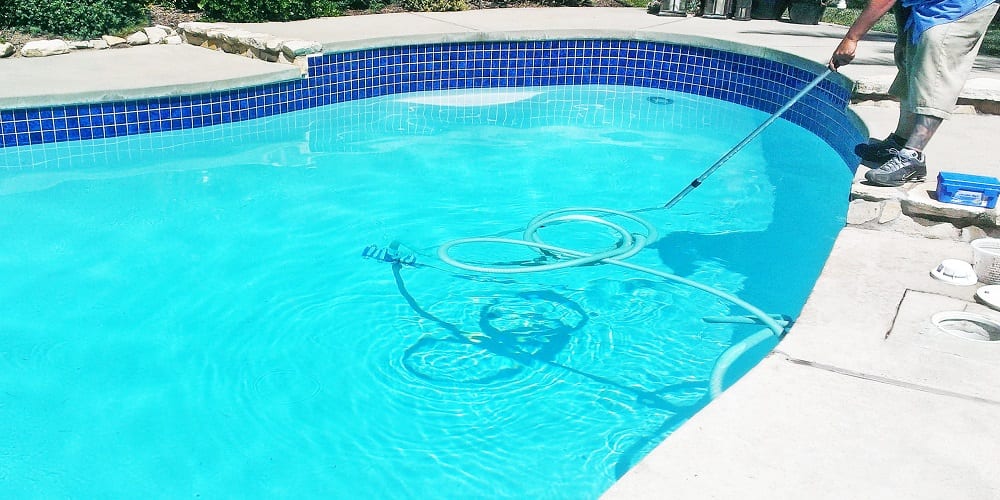
How To Vacuum A Pool?
It might seem like a bit of drudgery, but one of the most important things that a pool owner can do to keep their pool in tip-top shape is to vacuum it regularly. Vacuuming a pool is one of the best ways to keep it clean, much like vacuuming your carpet is a good way to keep that clean. However, to get the best results from this process, the consumer has to not only vacuum the pool properly and regularly, but they also have to be diligent about the rest of their pool care routine. And that’s why we’ve written this article. We want to show everything that needs to be done to keep a pool in good condition so new pool owners will have no problems keeping their pools in good condition.
Steps For Vacuuming A Pool With A Manual Vacuum
Okay, this first section is going to show our readers how to vacuum their pool using a manual pool vacuum. After we’ve completed this initial step, we’ll then move on to using automatic pool vacuums properly and then after that, we’ll move on to other steps the pool owner can take to keep their pool in the best condition possible.
Step One: Assemble Your Tools
The first step that has to be taken before you can vacuum your pool is to gather together the right tools. And it needs to be noted that these tools should be gathered together and properly checked before beginning the whole process of vacuuming the pool. Some of the things that you’re going to need to include the following items.
Vacuum Head With Telescopic Pole
The vacuum head is the part that actually goes into the pool for vacuuming, so it’s important to buy a quality one. Another thing that you’ll need is a good telescopic pole. Telescopic poles should be able to be used not only with your vacuum head but also with any brush heads or nets that you might have for cleaning your pool.
Vacuum Plate
It’s also important to have a vacuum plate. This product is also called a skimmer plate, and it’s designed to connect the hose to the skimmer inlet of the pool.
Vacuum Hose
The vacuum hose connects the vacuum head to the pool pump through the skimmer inlet. It’s the skimmer inlet that provides the suction for the vacuum.
Step Two: Setup The Equipment
This stage of the pool vacuuming process concerns itself with properly setting up the equipment with the pool’s filtration system for cleaning. Let’s take a closer look at this process, shall we?
Assemble The Pool Vacuum
This part is pretty straightforward, but we’ll give it a few seconds of our time. All this entails for most manual pool vacuums is to attach it to the vacuum hose.
Connect The Vacuum Hose
One end of the vacuum hose is attached to the vacuum head, and then the other end is attached to the telescoping pole. All of this should snap together rather easily, so if it doesn’t, then the equipment might need to be reexamined and any instructions that came with the equipment revisited to make sure that you’re putting it together properly.
Set The Filter Valve Setting
Although there may be different pool filtration systems that have different options, most of them have a standard configuration, so we’ll address that one in this section. For most people, light vacuuming can be done by setting their multiport valve filter to “Filter.” If they have heavier vacuuming to do because there’s a lot of pool debris, then they can set it to the “Waste” setting. The difference between these two settings is that the “Filter” setting will send the water and debris through the filter, while the “Waste” setting will send it down the drain.
Step Three: Begin Vacuuming
As far as the vacuuming process goes, it’s accomplished in much of the same way as you would use a carpet vacuum. You should take your time, make straight passes, and do one section at a time. If the pool is filthy, then you might have to stop the process so you can empty the pump strainer during the process. You might also have to repeat the vacuuming process to ensure that the pool is clean.
Step Four: Cleanup After The Vacuuming Process
After the pool has been thoroughly vacuumed, it’s now time to clean things up. You can start by making sure that you disconnect your hoses from the skimmer inlet and also from the vacuum head. It’s also important to make sure that you clean out your skimmer as well and set the filter setting back to the way they were before you began.
How To Operate An Automatic Pool Cleaner
Even though we think we did a pretty thorough job explaining the process of vacuuming a pool with a manual pool vacuum, we wanted to expand on this article and take a little bit of time to talk about automatic pool cleaners. Although these aren’t technically called pool vacuums, many of them work in much of the same way as manual vacuums—except you don’t have to do as much work.
In our experience, automatic pool cleaners come in one of three “flavors.” These include Suction Side Pool Cleaners, Pressure-Side Pool Cleaners, and Robotic Cleaners. Let’s briefly examine each one and see how each one should be set up and used.
Suction-Side Pool Cleaners
Suction-side pool cleaners are some of the hardest to set up correctly because they’re attached to the suctioning side of the pool. They’re basically automatic versions of manual pool vacuums, they just move automatically on their own. Below are some steps for using a suction side pool cleaner.
Step One: Get Your Pool & Equipment Ready
During this part of the process, you should make sure to clean out the pump basket and make sure that the pump filter is clean as well. If it’s not, then you’re going to have to backwash it and rinse it.
It’s also a good idea to check the pH level of the pool. Some suction side pool cleaners are designed to work in pools of specific pH levels. If a cleaner is used in a pool that has chlorine or calcium levels that are too high, then it might end up getting ruined.
The last thing that you’ll need to do before cleaning is to close the drain outlets and the pool suction outlets. All except for where the skimmer hose line is attached. Also, make sure to make sure that the pool pump is completely turned off.
Step Two: Hooking It Up And Using It
The next thing that you’re going to want to do is to remove the basket from the skimmer port and then screw in the compression adapter at the bottom of the port in the connector. When this has been done, you should then install the regulator valve at the end of the compression adapter. The next step is to attach the hose of the automatic cleaner into the skimmer hose and make sure it works.
When it’s properly set up, the automatic cleaner can then be placed on the surface of the pool. Wait for the water to come through the hose and the air from the unit has been expelled. Now thread the hose’s end through the skimmer opening of the pool. If the automatic cleaner is acting in accordance with its manual, then the cleaner can be left to do its job. On the other hand, if the automatic cleaner isn’t moving as fast as it should, then it might be malfunctioning. If that’s the case, then consult with your owner’s manual to find out how to correct it.
Pressure-Side Pool Cleaners
The next type of automatic cleaners is pressure-side pool cleaners. These products use pressure to move around the pool. These products are good for people who are dealing with debris such as acorns or small branches in their pool. These products filter pool water as they go and then sent it right back out to the pool. Installing these cleaners are very similar to other models, but make sure to consult your owner’s manual for blow-by-blow instructions. Below are some things to think about when installing a new pressure-side cleaner.
- The pool should have a dedicated pressure line.
- There should be a proper female fitting for the pressure line.
- The return line should be flushed out by turning the pump on for a minute and then back on.
- A wall fitting is going to have to be installed.
- The disconnect in the wall fitting should be installed.
- The hose should be the right length for your size pool.
Robotic Pool Cleaners
Robotic pool cleaners are some of the easiest models to use. They’re easy to hook up and they are easy to use. They do require a GFCI-protected plug near the pool, and that the pool owner thoroughly read the product’s instructions, but once that’s done, it’s easy to use.
Since each of these robotic pool cleaners is different from one another, we can’t give an overview of the entire process. What we can do, however, is to tell all of our readers how these devices work, so let’s take a quick look at that process before moving on.
Robotic pool cleaners are designed to move across the various pool surfaces, all while vacuuming while it’s moving in. the vacuumed dirt is deposited into a mesh bag that the robot either carries with it or is attached to the side of the pool. These cleaners not only help to relieve some of the stress off of the pool’s filtration system, but they can also reduce the number of chemicals the pool owner uses in their pool.
A Quick Guide To Pool Cleaning
Now that we’ve covered some of the more common pool vacuums and have talked about how pool owners can vacuum their pool, it’s now time to turn our attention to giving our readers some of the more important information. This information is how often the pool should be cleaned.
When it comes to pool cleaning, there are 3 distinct steps in the entire process. There’s Skimming Off Debris, There’s Brushing Sediment From Walls, and of course, there’s Vacuuming The Pool. Let’s examine each of these cleaning steps so that you know exactly how often each one should be accomplished.
Skimming Off Debris
Skimming off debris from your pool is something that should be done daily. Sorry, there’s just no way around it. You should use a long-handled leaf skimmer to get rid of all of the insects, leaves, and other debris that might be floating around. This debris should be removed, if possible before it sinks to the bottom of the pool. If you find yourself having to do a lot of skimming, then you might want to trim back any trees that might be around the pool area.
Brushing Sediment From The Walls
You should also make sure that you remove dirt that has collected on the sides and bottom of the pool using a pool brush. Don’t forget to also remove sediment from ladders and slides as well. Make sure to brush the sediment towards the main drain so that it can be vacuumed up. Make sure to brush the pool’s walls and floor once a week.
Vacuuming The Pool
The last thing that should be done is to vacuum the pool. This should also be done once a week, right after the pool has been brushed. That will produce the best results and ensure the pool is clean.







